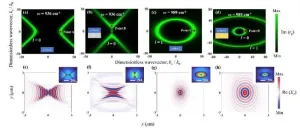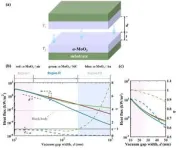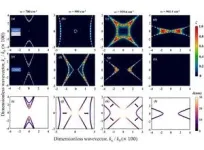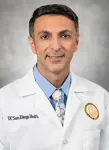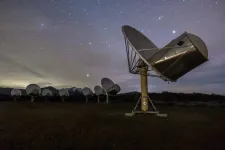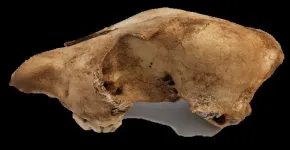A new publication from Opto-Electronic Advances; DOI 10.29026/oes.2024.230053 , discusses forbidden propagation of hyperbolic phonon polaritons and applications in near-field energy transport.
Manipulating photons on the nanoscale to develop integrated and miniaturized optoelectronic devices as well as photonic chips has been a strong pursuit of the nanophotonics community. Among them, phonon polaritons supported by two-dimensional layered van der Waals (vdW) materials, which have emerged in recent years, have attracted much attention by virtue of their ultra-long lifetimes, ultr-low losses, and strong confinement capabilities, and have shown great promise in the fields of sub-wavelength imaging, anomalous refraction, superlensing, thermal management, and so on. A vibrant research field is emerging to break through the diffraction limit of conventional optics in the form of polaritons and to manipulate the interaction between light and matter.
Tunable phonon polaritons are the basis for enhanced manipulation of photonic devices. Currently available tuning strategies for phonon polaritons are mostly limited to the construction of nano-patterned structures on the vdW material itself, such as sub-wavelength periodic array structures (gratings, etc.), or twisted multilayered structures to create an photonics magic angle, as well as electromagnetic tunable construction of vdW heterojunctions based on graphene, where the nanostructures increase losses, and twisting limits the application of monolayer materials, so exploring more modulation methods is of non-negligible significance to manipulate the excitation and propagation of phonon polaritons. In addition, it is of great practical value to explore the effect of phonon polaritons coupling on near-field thermal energy transport.
The authors of this article propose a strategy to drive the phonon polaritons propagation in vdW material (molybdenum trioxide, α-MoO3) with the help of the substrate, so that the direction of the propagation direction of hyperbolic phonon polaritons can be reoriented by 90°to achieve the forbidden propagation. At the same time, the role of substrate-dependent phonon polaritons coupling in near-field thermal radiation is described and the influence of the correlation between width of air spacing and thickness of α-MoO3 slab on the radiative heat transfer is investigated.
Based on the derivation of the dispersion equation, the team members theoretically provide the relationship between the propagation direction of hyperbolic phonon polaritons and the substrate dielectric function, which shows that the hyperbolic phonon polaritons along the x-axis (Fig. 1(a, e)) and the y-axis is forbidden to propagate when there is no substrate or the real part of the substrate dielectric function is positive. In contrast, when the real part of the substrate dielectric function is negative and its absolute value must not be too big such as in SiC, the direction of propagation is reoriented by 90°, and then it can propagate along the forbidden direction (Fig. 1(b, f)). For metallic substrates such as Au, the fundamental mode can be excited with l=0 (Fig. 1(d, h)), compared to the suspended configuration where the lowest mode is l=1 (Fig. 1(c, g)).
Substrate-dependent polaritons are applied to radiative heat transfer (Fig. 2(a)) to investigate the effect of SiC and Au substrates on the NFRHT between two α-MoO3 slabs and compare it with the case without substrate. It is found that whether the SiC substrate enhances or suppresses the radiation depends on the relative amplitude of thickness of the α-MoO3 slab and the width of air spacing. As shown in Fig. 2(b), when the vacuum width varies, the whole region can be divided into a nearly inactive region, an inhibition region, and an enhancement region from left to right based on the effect of SiC. In other words, for a certain thickness, the smaller the spacing width, the less effective it is. This is due to the fact that when the spatial distance is smaller than the thickness of the slab, the wavevector region of the mutual coupling of the excited polaritons of the slab does not differ much from that of the infinite bulk, resulting in a slab that can be equivalently treated as a bulk material at this point in time, and thus the substrate is not effective for energy transfer (Fig. 3).
Keywords: femtosecond laser / GHz burst mode / ablation / LIPAA / laser induced plasma assisted ablation / sapphire
# # # # # #
Xiaohu Wu graduated from China University of Mining and Technology (Beijing) with a bachelor's degree, and graduated from Peking University with a doctorate degree. He is now a researcher of Shandong Institute of Higher Technology, a superior youth of Shandong Province, a young expert of Taishan Scholars of Shandong Province, a member of the board of directors of the International Center for Heat and Mass Transfer (ICHT), and a member of the list of the "Top 2% of the world's leading scientists (2023)" released by Stanford University in the United States. He was selected as one of the "Top 2% of Global Top Scientists (2023)" by Stanford University. He is mainly engaged in research in the fields of radiative heat transfer, solar photothermal utilization, and micro-nano photonics, etc. His doctoral dissertation was awarded as the Excellent Doctoral Dissertation of Peking University and was published in full English by Springer Press. His work on hyperbolic materials was selected by the Optical Society of America as one of the world's top 30 optical advances in 2020, "Optics in 2020". He has been awarded the Hartnett-Irvine Award of the International Center for Heat and Mass Transfer (2019), Forbes China's 30 Under 30 Science and Technology Elites (2021), Outstanding Communist Party Member of Shandong Province Provincial Organs (2023), and the 28th Chinese Youth May Fourth Medal (2024), among other honors.
# # # # # #
Opto-Electronic Science (OES) is a peer-reviewed, open access, interdisciplinary and international journal published by The Institute of Optics and Electronics, Chinese Academy of Sciences as a sister journal of Opto-Electronic Advances (OEA, IF=9.682). OES is dedicated to providing a professional platform to promote academic exchange and accelerate innovation. OES publishes articles, reviews, and letters of the fundamental breakthroughs in basic science of optics and optoelectronics.
# # # # # #
More information: https://www.oejournal.org/oes
Editorial Board: https://www.oejournal.org/oes/editorialboard/list
OES is available on OE journals (https://www.oejournal.org/oes/archive)
Submission of OES may be made using ScholarOne (https://mc03.manuscriptcentral.com/oes)
CN 51-1800/O4
ISSN 2097-0382
Contact Us: oes@ioe.ac.cn
Twitter: @OptoElectronAdv (https://twitter.com/OptoElectronAdv?lang=en)
WeChat: OE_Journal
# # # # # #
Obata K, Kawabata S, Hanada Y et al. High performance micromachining of sapphire by laser induced plasma assisted ablation (LIPAA) using GHz burst mode femtosecond pulses. Opto-Electron Sci 3, 230053 (2024). doi: 10.29026/oes.2024.230053
END
